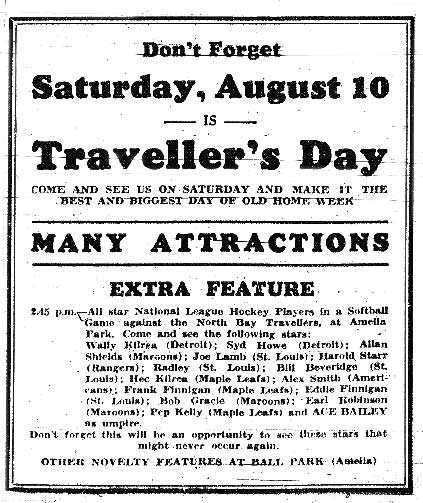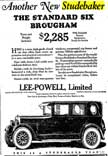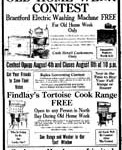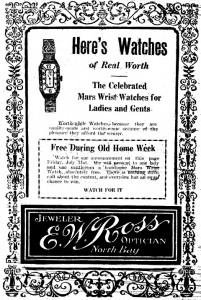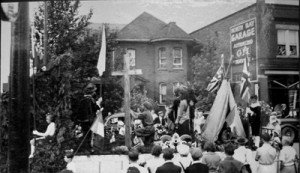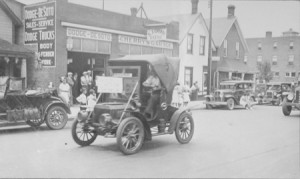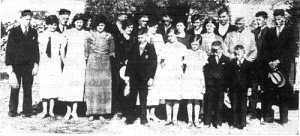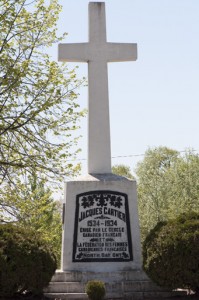“Old Timers Fail to Recognize Town They Left Years Ago.” The Nugget, August 7, 1935, front page, 2.
[Transcribed by F. Noël with permission.]
Old Timers Fail to Recognize Town They Left Years Ago
Residents of Early Days Are Greatly Impressed By Progress Made
MANY PIONEERS RETURN
Memories of North Bay when it was only a struggling backwoods town, when rocks sand and stumps were everywhere, when, there appeared little likelihood that anything would come of the attempt to establish a settlement here, when a large lot at the corner of Main and Ferguson streets sold for $25—all these were recalled for The Nugget this week by old timers who have come back for Old Home Week.
Although several of the visiting pioneers were contacted for their memories, and for their opinions of the city of today, it was impossible to reach even a small portion of the large number who have returned to their early home. From the moment an old timer arrives in the city he, or she, is so busy shaking hands with old friends, and going from place to place in a round of calls, attempts to find them at a definite place are almost futile.
Busy Bureau
The Old Home Week registration bureau located in the Board of Trade Information Bureau has been the mecca for hundreds of old timers, however, and here it is possible to contact a few of the many who have come to town.
“Why if we stay here a few days longer, we will be moving back,” was the way John Scott, a veteran C.P.R. engineer summed up, and so saying about expressed the reaction the North Bay of today. Incredulity that a city could have sprung from the humble beginning of the early 80s, the thought that “North Bay would always be home” came from other old timers, as without exception they waxed enthusiastic over the old days and the new.
Corner Lot for $25
Fifty years ago the corner lot on which T.M. Palmer’s jewelry store now stands, at the corner of Main and Ferguson streets, was just sand, rock and stumps, and was sold for $25, W.J. Kellogg, a veteran railroader recalls who used to make his home in North Bay recalls. With Mrs. Kellogg, the former Elizabeth Foster, one of the city’s pioneer school teachers, Mr. Kellpgg travelled from Desbarats, near Sault Ste. Marie to be in the city for Old Home Week.
In 1900 Mr. Kellogg left North Bay to become C.P.R. agent at Desbarats, and George W. Lee, also a veteran of the rails, recalled going to Desbarats more than 30 years ago to witness a presentation of “Hiawatha” by Indians resident near
(Continued on Page 2, Col. 5)
OLD TIMERS
(Continued from Page One)
Desbarats and then chatting with Mr. Kellogg.
While coupling cars at Desbarats some years ago, Mr. Kellogg lost his right arm, but trained himself to work a telegraph key by his left hand. He will in 1936 complete 40 years as a member of the telegraphers’ union.
In Mrs. Kellogg’s teaching career, she was one of the first teachers in the old “log school.” Later when the city’s first permanent school was erected, the present Worthington street school, she moved to that building and taught there for a number of years before her marriage.
Comparing the cities of the North with those of 40 or more years ago, Mr. Kellogg recalls that North Bay, Sudbury and Sault Ste. Marie were straggling villages in those days, and that there were no settlements what-ever north of these centers.
Jack Shotton, another old-time railroader, now retired and living at Montreal, is a visitor to the city for Old Home Week. The son of a former C.P.R. locomotive foreman here, Mr. Shotton rose to be district master mechanic on the C.P.R., stationed at Brandon, Manitoba.
Always His Home
W.J. Johnson, a former C.P.R. engineer at North Bay, and now a Canadian National Railway engineer at Hornepayne, recalled with George W. Lee the days of long ago when he was engineer on a construction train, and Mr. Lee was “slinging ties” in railroad parlance on the same train.
Stationed at Hornepayne for the last 19 years, Mr. Johnson is visiting the city for the first time in several years. Although he has been away for some time, Mr. Johnson says that North Bay will always be home to him.
Came from B.C.
Before Canadian Pacific Railway track- laying crews reached North Bay in September, 1882, two Canada Central train crews from Pemborke were sent to Lake Nipissing to superintend the loading of ties and timbers for shipment to Mattawa, whence they found their way into Canada Central tracks.
One of the members of those train crews was Patrick Carmody, the engineer who piloted the first C.P.R. construction train into North Bay, right on the heels of the track layers. Today Mr. Carmody is back in the Bay for Old Home Week, back to a city which was a struggling settlement of a few hundred souls when he left in 1887.
With Mr. Carmody on one of those Canada Central crews in 1882 was James Fallon Sr., one of North Bay’s oldest residents, and the man who stoked the first C.P.R. train piloted by Engineer Carmody.
“We were working on the old Canada Central in those days,” the two old timers reminisced today, “and as fast as we could get it built the C.P.R. came along and took it away from us. We were working on construction trains, and no sooner would we get a few miles of track laid when the C.P.R. would take it over. Those were great days just the same.”
Leaving North Bay in 1887, Mr. Carmody successively worked on the Great Northern Railway, the Montana Central, and the Butte, Anaconda and Pacific in the United States, before going to Anyox, British Columbia, where he was for several years employed at the huge Granby Consolidated smelter, which closed down a few weeks ago after many years steady operation.
Mr. Carmody left the company about a month before the smelter was closed, “I figured that 53 years was long enough to work, so I’m taking it easy now.”
“I suppose there are a lot of changes since you left here in 1887,” The Nugget suggested.
“Why I hardly knew where I was until Jim, (Mr. Fulton) took me down and showed me where the old “Red Row” used to stand, and to the lake where the old dock stood. North Bay has grown into a marvellous city since I left it,” Mr. Carmody enthused.
In Construction Days
“If we stay in the city a few days longer, the first thing we know we will be moving back,” John Scott, another North Bay old timer, and now a resident at Trenton, told the Nugget in a brief moment of recollection Tuesday afternoon.
When we first came to North Bay, in the summer of 1883,” Mr. Scott said speaking of Mrs. Scott and himself, “the C.P .R. was still under construction between here and Mattawa. The only buildings erected then were Doyle’s boarding house, McFarlane’s boarding house, and John Ferguson’s log home. It wasn’t long though, before the row which was later to be known as “Rogers’ Row,” then “Green Row”, and later “Red Row” was started. I can well remember when the men were working on that they had to be careful to always stand on a board, or they would sink up their knees in muskeg.
“Back in 1883, I couldn’t imagine that a city like this would ever arise on this spot.” Mr. Scott recalled. “Even in the early days of the settlement it was hard to realize that a community was springing up. The location was not impressive, and to the men who have built the wonderful North Bay of today must go a world of credit.”
A charter member of Nipissing Masonic Lodge, and a member of the first board of Rev. Silas Huntington’s pioneer Methodist Church, Mr. Scott spent several years in the old city as a C.P.R. engineer. Leaving in 1888 because of Mrs. Scott’s poor health, Mr. and Mrs. Scott made their home in Toronto, although they lived a few years at Kenora. While running out of Kenora, Mr. Scott was engineer on the first C.P.R. train to enter Winnipeg, then a small settlement like North Bay.
After residing in Toronto for several years Mr. and Mrs. Scott moved to Trenton where they now make their home. Mr. Scott is retired, and owns a small farm on the outskirts of Trenton.
Amazing Progress
After having travelled from coast to coast in Canada several times, I have yet to find a town which has made such fast progress in the last 25 years as North Bay.” Such a tribute was paid this day W.J. Major, Ottawa, who with Mrs. Major is visiting Mr. and Mrs. W.B. Childerhose, 418 Main street west, for Old Home Week. Mr. and Mrs. Major resided in North Bay from 1882? until 1890?, when they moved to Ottawa.
Familiar with this part of the province since 1884, Mr. Major was with the car department of the C.P.R. and estimates that at the time of his residence here the population was about 2,000 persons. He recalls working with George Bury, now of Vancouver, who will be remembered by many of the old time residents of North Bay.
In the latter years of the 19th century, the town was progressing rapidly. It boasted four hotels, the Mackey House, Winnipeg, Queen’s and Pacific and six churches, St. Andrew’s, Presbyterian, Methodist, Baptist, Anglican and Roman Catholic.
During their visit in the city for Old Home Week Mr. and Mrs. Major visited the house they built while living here. Of brick veneer, it was moved from its former site, the corner of John and Railroad streets, when the T. and N. O. tracks was laid and now faces north on Main street. Although built in 1906 the house is still in good condition.
Mr. and Mrs. Major agreed that if they were to move again they’d come right back to North Bay where they both have many friends. On this trip they are returning from the Peace River district, where they visited Mrs. W.H. McNeil, Beverlodge, and where for three weeks they were detained because of floods.

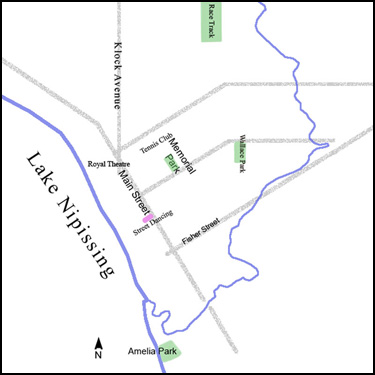
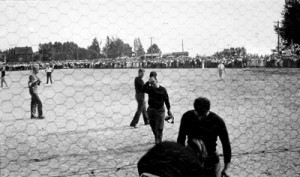 Games which featured Old Timers were also crowd pleasers. As expected, large crowds turned up to watch Old Time baseballers including “Boxcar McDonald”, “Gutty” Lockhart, and “Cap” Weegar in a challenge game against the CPR Ceepees. A photo (left) of a baseball game in 1935 suggests that large crowds watched some of the games.
Games which featured Old Timers were also crowd pleasers. As expected, large crowds turned up to watch Old Time baseballers including “Boxcar McDonald”, “Gutty” Lockhart, and “Cap” Weegar in a challenge game against the CPR Ceepees. A photo (left) of a baseball game in 1935 suggests that large crowds watched some of the games.